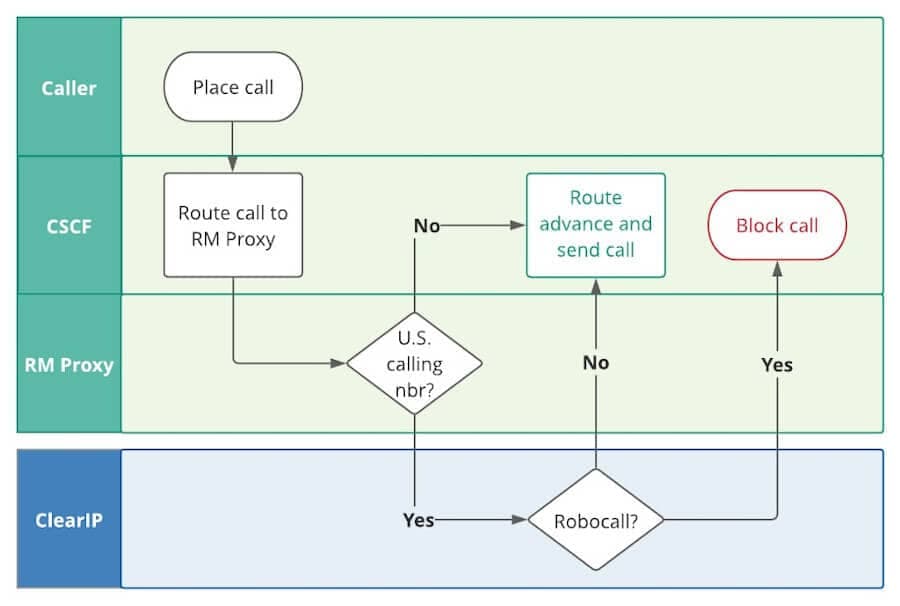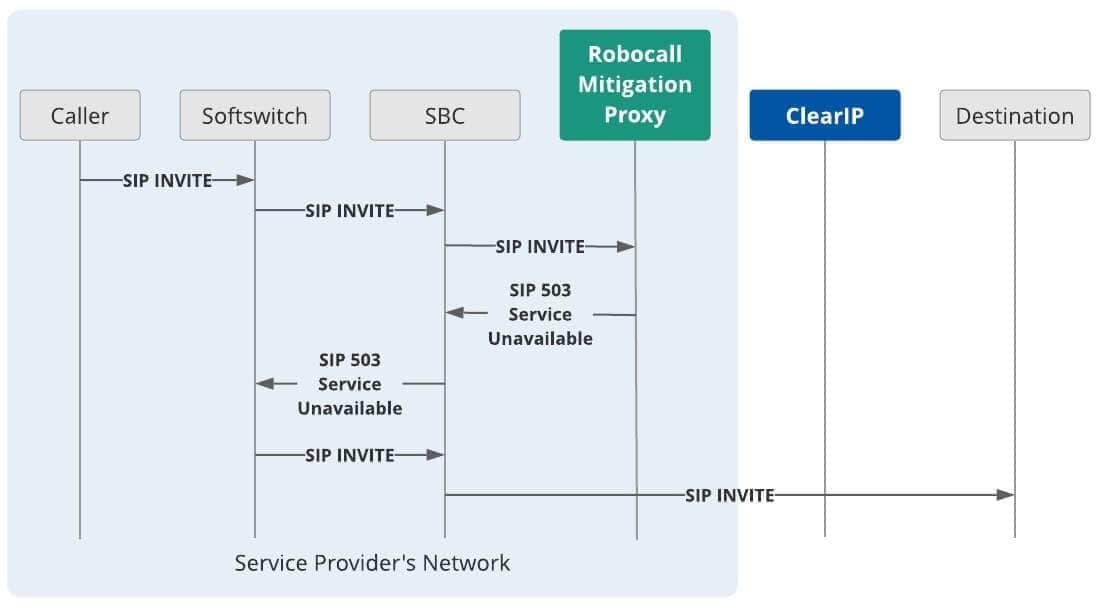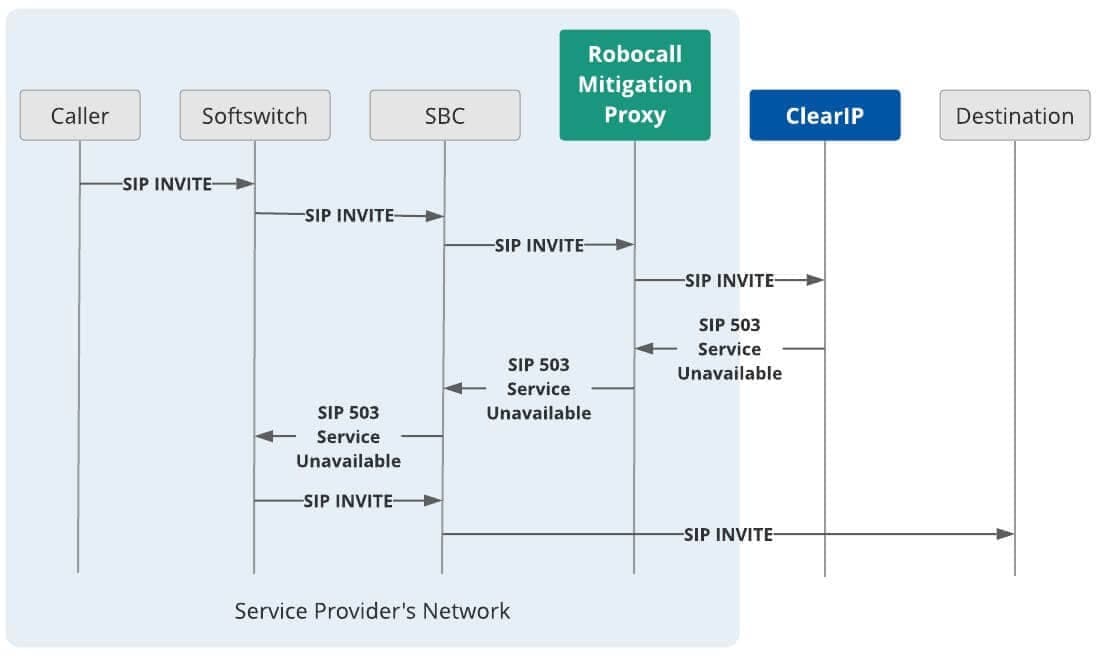Robocall mitigation for non-U.S. service providers
Starting September 28, 2021, unregistered international wholesale voice service providers will have their calls with U.S. calling numbers to the U.S. refused.
The TransNexus Robocall Mitigation for Non-U.S. Service Providers solution enables international wholesale voice service providers to:
- Deploy the TransNexus robocall mitigation program for calls to the U.S with U.S. calling numbers.
- File a certification in the FCC Robocall Mitigation Database (RMD).
- Have its calls with U.S. calling numbers accepted by U.S. service providers in compliance with FCC rules.
Benefits
Robocall Mitigation for Non-U.S. Service Providers has several benefits:
- Easy to deploy:
- Only one thing to install in your network: the Robocall Mitigation Proxy (RM Proxy)… and that’s optional.
- Only one configuration change: Send calls destined for the U.S. to the RM Proxy (or directly to ClearIP).
- Has no impact on other call traffic.
- It’s an easy way to satisfy the FCC requirement for an effective robocall mitigation program.
- Enables you to file a proper robocall mitigation certification in the FCC Robocall Mitigation Database (RMD).
- Enables U.S. service providers to accept your calls with U.S. calling numbers.

- FCC requirements
FCC Second Report and Order on SHAKEN
The FCC’s Second Report and Order, paragraph 86, issues the following rule:
We prohibit intermediate providers and terminating voice service providers from accepting voice traffic directly from any voice service provider that does not appear in the database, including a foreign voice service provider that uses NANP resources that pertain to the United States to send voice traffic to residential or business subscribers in the United States.
The following illustration explains the service providers in the call path that will be affected.

Multinational call path to the U.S.
In this illustration, the two U.S.-based voice service providers to the right, near the end of the call path, are subject to the FCC rule. They must check that each upstream provider from whom they receive calls directly has a registration in the RMD. U.S. providers cannot accept calls with U.S. calling numbers directly from unregistered providers.
This rule impacts the international wholesale provider in the illustration. This provider must have a certification on file in the RMD, else the U.S. gateway provider cannot accept its calls with U.S. calling numbers.
The FCC Second Report and Order explains the filing requirements in paragraph 82:
We require all voice service providers to certify that their traffic is either “signed with STIR/SHAKEN or . . . subject to a robocall mitigation program” that includes “tak[ing] reasonable steps to avoid originating illegal robocall traffic,” and committing to cooperating with the Commission, law enforcement, and the industry traceback consortium in investigating and stopping any illegal robocallers that it learns are using its service to originate calls.
Since non-U.S. voice service providers cannot be approved by the U.S. STI Policy Administrator to sign calls with SHAKEN, they must deploy a robocall mitigation program and certify it in their RMD filing.
- How Robocall Mitigation for Non-U.S. Service Providers works
RM Proxy
Some international wholesale providers might have difficulty applying robocall mitigation to only their calls with U.S. calling numbers. Robocall Mitigation for Non-U.S. Service Providers provides a Robocall Mitigation Proxy (RM Proxy) to make this easy. The RM Proxy identifies calls with U.S. calling numbers and sends them to ClearIP for robocall mitigation. The following flowchart explains this logic.

International Robocall Mitigation logic
Here’s how the RM Proxy is used:
- The Call Session Control Function (CSCF) sends SIP INVITEs for calls destined for the U.S. to the RM Proxy.
- The RM Proxy checks whether the calling number is in the U.S. NANP.
- If yes, the RM Proxy sends the SIP INVITE to ClearIP.
- If no, the RM Proxy returns either a SIP 503 or SIP 404 (configurable option) to the CSCF. The CSCF route advances and sends the call along the call path.
The RM Proxy is optional. It’s intended for international wholesale providers who would find it difficult to identify calls with U.S. calling numbers. If you prefer, you can configure your CSCF to send SIP INVITEs with U.S. calling numbers directly to ClearIP for robocall mitigation.
- ClearIP receives SIP INVITEs and performs robocall mitigation to identify robocalls.
- If it’s a robocall, ClearIP returns a SIP 603. The CSCF blocks the call.
- If not a robocall, ClearIP returns either a SIP 503 or SIP 404 (configurable option). The CSCF route advances and sends the call along the call path.
See the RM Proxy installation instructions for further details.
SIP ladders
The following illustrations provide SIP ladders for two scenarios to detail how these elements communicate. In these ladders, the international wholesale provider is using the RM Proxy.

SIP ladder for a call with a non-U.S. calling number
In this call ladder, the RM Proxy returns a SIP 503 (alternatively, can be configured to return a SIP 404) to the softswitch. The softswitch route advances and sends the call down the call path.

SIP ladder for a call with a U.S. calling number
In this call ladder, the RM Proxy sends the SIP INVITE to ClearIP for robocall mitigation. ClearIP determines that the call is not a robocall, so it returns a SIP 503 (alternatively, can be configured to return a SIP 404) to the RM Proxy, which returns it to the softswitch. The softswitch route advances and sends the call down the call path.
If ClearIP robocall mitigation determines that the call is a robocall, then it returns a SIP 603, which causes the softswitch to block the call.
Contact us today to learn how we can help you deploy Robocall Mitigation for Non-U.S. Service Providers quickly and easily.
TransNexus has a comprehensive suite of robocall mitigation solutions to prevent the origination of unlawful robocalls.
Learn more about robocall mitigation